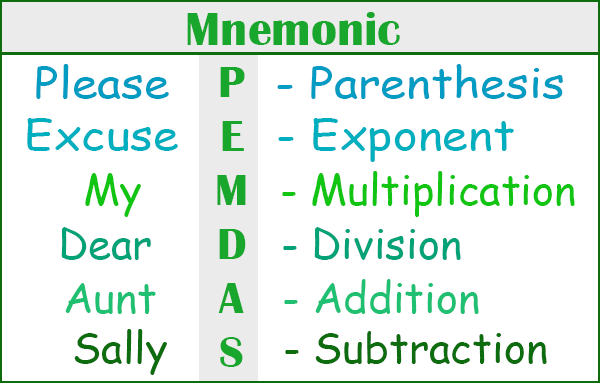I. What is a Mnemonic?
A mnemonic, also known as a memory aid, is a tool that helps you remember an idea or phrase with a pattern of letters, numbers, or relatable associations. Mnemonic devices include special rhymes and poems, acronyms, images, songs, outlines, and other tools. Mnemonic (pronounced ni-mon-ik) is derived from the Greek phrase mimnēskesthai meaning to “remember.”
II. Examples of Mnemonics
Example 1
PEMDAS – Please excuse my dear Aunt Susie.
PEMDAS is a common mnemonic for remembering order of operations in pre-algebra meaning: Parentheses, exponents, multiplication, division, adding, and subtraction.
Example 2
EADGBE – Elephants and Donkeys Grow Big Ears
This mnemonic is useful for remembering the strings of a guitar in proper order from left to right.
Example 3
I before e except after c
This phrase is a mnemonic which reminds spellers that typically the letter i comes before e and after c. For example, the words “lie,” “belief,” and “pie” all have i before e. Words like “deceive” and “ceiling,” on the other hand, have e before i, following the letter c.
III. Types of Mnemonics
Types of mnemonics range from simple catchphrases to the creation of abbreviations and phrases. Here are a few types of mnemonics commonly used:
a. Connection Mnemonics
Connection mnemonics are used when one can make a connection between something already known and the new thing to memorize. For example, imagine you meet a new boy named Brian who has a bowl cut. You can remember his name by saying Bowl Cut Brian in your head—the connection of his haircut with his name and the “B” alliteration is a helpful memory aid!
b. Image / Model Mnemonics
Sometimes, actual images and models are useful for visual learners, or learners who memorize well with graphs, charts, pictures, and similar devices. For example, parts of a plot are often memorized more easily when arranged on a pyramid shape:
c. Music Mnemonics
This type of mnemonic is self-explanatory: many of us simply remember better when music goes along with the phrase or concept we are learning. A simple example of this is using the “ABC” song to learn the alphabet.
d. Name Mnemonics
With this type of mnemonics, the first letters of the words within a phrase are used to form a name. Memorization of the name allows for memorization of the associated idea. For example, Roy G. Biv is a name used to remember the colors of the rainbow: red, orange, yellow, green, blue, indigo, and violet.
e. Name of Expression Mnemonics
In this common type of mnemonic, the first letter of each word in the phrase is used to create new words with a memorable phrase. One example of this is the 7 coordinating conjunctions For, And, Nor, But, Or, Yet, and So which create FANBOY.
f. Note Organization / Outline Mnemonics
One simple way of remembering things better is simply organizing information. Ways of organization include creating notecards to practice studying terms and definitions and to create outlines of one’s notes. For example, see this outline of plot:
1.Exposition
- Definition:
- Example:
2.Rising action
- Definition:
- Example:
3.Climax
- Definition:
- Example:
4.Falling action
- Definition:
- Example:
5.Denouement
- Definition:
- Example:
g. Spelling Mnemonics
Spelling mnemonics are rules, patterns, or phrases used to remember certain difficult spellings. Here are a few common examples:
- Never believe a lie.
- There’s a rat in separate.
- Because: Big Elephants Can Always Understand Small Elephants
IV. The Importance of Using Mnemonics
Mnemonics are cheat codes for those who struggle with memorizing a certain complicated subject, list, or concept. They allow us to use more memorable phrases that tie the concepts we want to memorize to our minds. They allow us to quickly and successfully learn, and remember key concepts in a variety of subjects from English to math. They work because our minds tend to remember information to which we can relate or experience.
Mnemonics have been proven to work as tools of memory-forming for a variety of tasks. They aid doctors, scientists, geologists, artists, and students. If you’re struggling to remember something, consider making yourself a mnemonic.
V. Examples of Mnemonics in Literature
Just as mnemonics are used in other subjects, they are often found in literary studies. Here are a few examples of literary mnemonics:
Example 1
Wherever there is a Q there is a U too.
This literary mnemonic reminds us with rhyme that Q’s are followed by U’s in spelling.
Example 2
We hear with our ear.
If you can spell “ear,” you can spell “hear” correctly, rather than “here.”
Example 3
Rhythm helps your two hips move.
This phrase helps the struggling speller: each first letter of the phrase spells out “rhythm.”
VI. Examples of Mnemonics in Pop Culture
Mnemonics can use pop culture references to help you memorize complicated lists or even facts about pop culture! Here are a few pop cultural examples of mnemonics:
Example 1
How to punish bad Daleks before many million earthlings truly see c
For those who are Who-obsessed, the actors who have played the doctor in the show “Dr. Who” can be remembered in chronological order with this phrase.
They are: Hartnell, Troughton, Pertwee, Baker, Davison, Baker, McCoy, McGann, Eccleston, Tennant, Smith, Capaldi.
Example 2
Does McDonald’s Sell CheeseBurgers?
This mnemonic uses pop culture to help children remember steps to complete division problems: divide, multiply, subtract, compare, and bring down.
VII. Related terms
Acronyms
Acronyms refer to words formed from abbreviations of certain phrases. For example, NASA is an acronym for National Aeronautics and Space Administration. Acronyms are often used as mnemonic devices. For example, the acronym HOMES can be used to remember the Great Lakes: Huron, Ontario, Michigan, Erie, and Superior.

